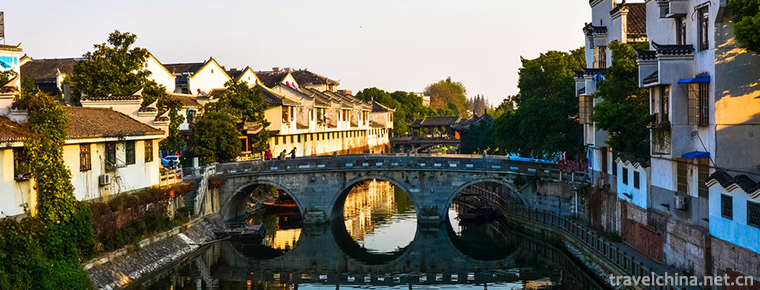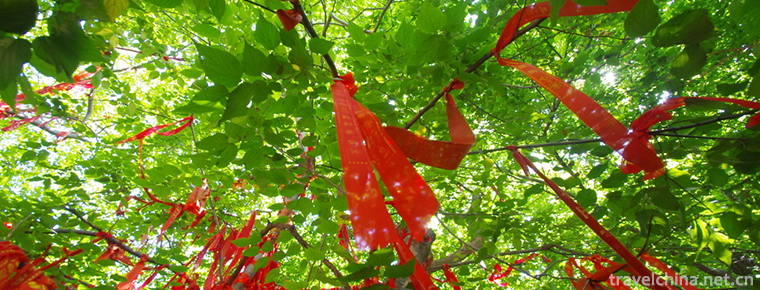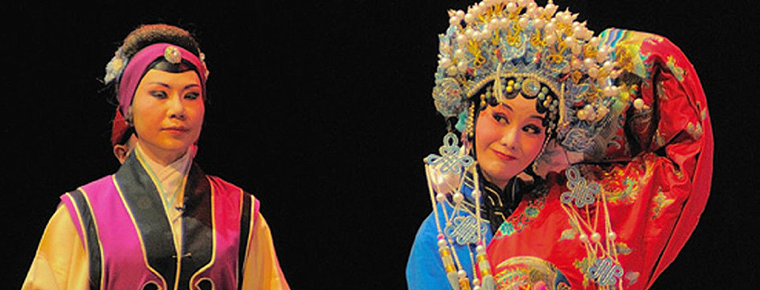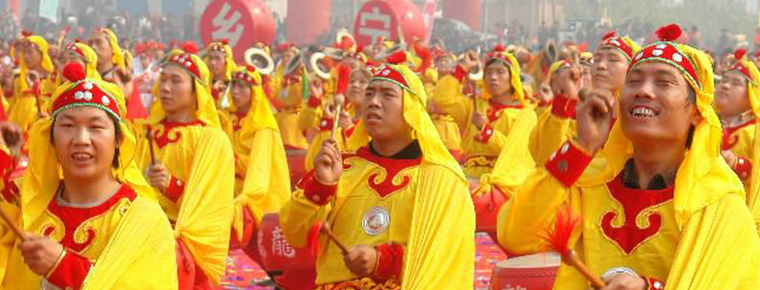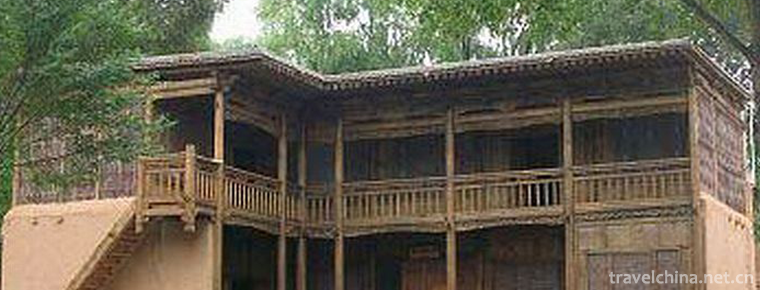Xibaipo Scenic Area Pingshan County Shijiazhuang
Xibaipo is located in the middle of Pingshan County, Shijiazhuang City, Hebei Province, with a total area of 16,440 square meters. It was the seat of the CPC Central Committee. The CPC Central Committee and Chairman Mao directed the three major battles of Liaoshen, Huaihai and Pingjin, which shocked China and foreign countries, and held the Second Plenary Session of the Seventh Central Committee and the National Land Conference of great historical significance to liberate China. Therefore, it has the reputation of "New China comes from here" and "China's destiny is determined in this village". As one of the revolutionary holy places in China, it is a national key cultural relics protection unit and national AAAAA class tourist attraction.
On March 23, 1949, the Central Committee of the Communist Party of China, the Central Military Commission and the headquarters of the Chinese People's Liberation Army moved from Xibaipo to Beiping.
In January 2017, the National Development and Reform Commission released the National Red Tourism Classic Scenic Spots List, and Xibaipo Scenic Spot in Pingshan County, Shijiazhuang was selected as the Chinese Red Tourism Classic Scenic Spots List.
Tracing to the source
Xibaipo, a small mountain village on the North Bank of Hutuo River in the mountainous area of Western Hebei Province, has not only beautiful scenery, but also beautiful soil and water. According to historical records, Xibaipo, originally known as "Baibo", was founded in the Tang Dynasty and was named for its lush green cypress on the hill behind the village. In 1935, a teacher in the village changed "Bu" to "Po", and because he lived opposite to "Dongbai Bu", he changed his name to "Xibaipo Village". She is situated at the intersection of North China Plain and Taihang Mountains, in a sunny horseshoe-shaped depression, surrounded by mountains on three sides, water on one side, Taihang Mountains on the west, and central Hebei Plain on the east, only 90 kilometers away from Shijiazhuang, a major town in North China. Transportation is convenient, easy to defend and difficult to attack. It is not only suitable for retreating into the mountains in time of crisis, but also convenient for marching into the city in time of success. From the perspective of economic conditions, the villages in Xibaipo village are dense, more than 1-2 kilometers apart, and distributed along the Hutuo River. The land near the mountains and rivers is fertile, the land is wide and the grain is abundant, and the rice and wheat are ripe. Marshal Nie Rongzhen once said, "Pingshan County can be called Ukraine in our Shanxi-Chahar-Hebei border region." The more developed agricultural economy is conducive to guaranteeing the economic supply of the army and the people and providing the material basis for the stationing of the Party Central Committee.
Xibaipo was chosen as the command center for liberating China and preparing for New China. It has not only its unique geographical conditions and natural environment, but also its revolutionary foundation and political advantages established over the years. The Pingshan County Revolution was launched early, and the Communist Party was established in the period of the Great Revolution. By 1946, there were 608 Party branches in the whole county. The number of Communist Party members had grown from 60 in 1931 to 19,535. The people listened to the Party and had a better mass base. Since the War of Resistance Against Japan, Pingshan County has been surrounded by two major bases in Shanxi-Chaji and Shanxi-Hebei-Shandong-Henan Border Region.
Pingshan County is the seat of the leading organs of the Fourth and Second Military Regions in the Jin-Cha-Ji Border Region. The Northern Branch of the Central Committee of the Communist Party of China, the government of the Jin-Cha-Ji Border Region and the Jin-Cha-Ji Military Region have also lived here for three and a half years. Pingshan County is a model county in the Jin-Cha-Ji border area, Xibaipo is a model village. Xibaipo founded the Party in the winter of 1937. By 1948, there were 40 Party members, distributed in 33 households, accounting for 12.3% of the total number of villagers and 33% of the total number of households.
Headquarters
There are many villages around Xibaipo. Why choose Xibaipo as the residence of the CPC? Pan Kaiwen, the Secretary of Commander Zhu De, took part in the inspection and selection on the spot at that time. He recalled: "We were thinking about this at that time: First, the village should be properly centralized and some organs of the later Commission should come and be able to let it go in the future (as for whether Chairman Mao or the Central Committee will come, nobody said, we don't know, and that should be in the future." Second, transportation should be convenient to facilitate contacts with the liberated areas; third, security issues. Although Hongzidian, Guosu, Jiayu and other villages are very large, they also have large goals and many people are not easy to keep secret. Xibaipo village is small, with a hill behind it for air defense and a distance from the surrounding village (about 1 kilometer), which is easy to keep secret. Fourth, accommodation conditions. Many houses in Xibaipo were burned by ghosts at that time, but they were well-founded and easy to build. They will live together in a more concentrated and convenient way to work in the future.
In 1948, the CPC Central Committee and Chairman Mao moved to Xibaipo, where they commanded the three major battles that shocked China and foreign countries, and held the Second Plenary Session of the Seventh Central Committee in 1949, which had a historic turning point.
Premier Zhou Enlai commented that "Xibaipo is the last rural command post for Chairman Mao of the Party Central Committee to enter Peiping and liberate China. It is here to direct the three major battles and hold the second plenary session of the Seventh Central Committee of the Party". After intensive preparations, on July 12, 1947, the Central Committee of Labour was formally established in Xibaipo. Of course, in order to meet the needs of the war environment, the Central Committee of Labor and Industry at that time was known as the "school of work" and "university of labor". Liu Shaoqi is the headmaster and Zhu De is the director. He is called President Hu (Hu Fu, Liu Shaoqi's alias) and the headmaster Zhu respectively.
After its stationing in Xibaipo, the CPC helped the Shanxi-Chahar-Hebei Field Army win four large-scale battles, wiping out more than 62,000 enemies. The Campaign of Liberation of Shijiazhuang is particularly famous.
On October 31, 1947, Zhu De participated in a meeting of brigade and above cadres held by the Command of Jin-Cha-Ji Field Military Region, and worked out a strategic plan for attacking Shijiazhuang with Yang Dezhi, Luo Ruiqing and Yang Chengwu. On November 1, we also called Nie Rongzhen and Xiaoke to request that the Jin-Cha-Ji Military Region be fully prepared for personnel supplement. From November 6 to 12, under the careful arrangement of Commander Zhu De, the Shanxi-Chahar-Hebei Field Army wiped out more than 24,000 enemies and successfully liberated Shijiazhuang. In summing up the experience and lessons of the battle, Commander Zhu happily wrote "Seven Laws to Overcome the Stone Gate": "Stone Gate blockades the Taihang Mountains, and the warriors open their hands. Destroy the whole division and take over the important town, do not call Huma back to Qinguan. Tactics to break new ground, long-suffering people laugh. Our party's heroes have come out in great numbers, never mind the temples.
Xibaipo is one of the five revolutionary holy places in China. It is a national key cultural relic protection unit and national AAAAA tourist attraction. It is located in Pingshan County, Shijiazhuang City, Hebei Province. It belongs to temperate monsoon climate. Once the seat of the CPC Central Committee, the CPC Central Committee and Chairman Mao commanded the three major battles of Liaoshen, Huaihai and Pingjin, which shocked China and foreign countries. They convened the Second Plenary Session of the Seventh Central Committee and the National Land Conference with great historical significance, which liberated China. Therefore, they have the reputation of "New China comes from here" and "China's destiny is determined in this village". 。 "China's destiny lies in this village," was the inscription of Comrade Zhu Muzhi, then director of the Foreign Propaganda Office of the Central Committee of the Communist Party of China.
In May 1947, the Central Committee of the Communist Party of China selected this place. In mid-May 1948, Comrade Mao Zedong led the headquarters of the Central Committee of the Communist Party of China and the People's Liberation Army to move here, making this ordinary mountain village the "last rural command post for the liberation of China" and the Communist Party of China to lead the people's and the People's Liberation Army and the country. The Democratic Party carried out a strategic decisive battle to create the command center of New China. From then on, Xibaipo, with its unique contribution, stood in the annals of Chinese revolution and erected an immortal historical monument. "New China is coming from here". This is a famous quote summarized by the writer, Comrade Yan Tao, when he wrote Xibaipo's documentary literature "A Journey to the East", and it serves as a subtitle of this documentary literature (which was used as the title of the book when it was reprinted in 1999).
When General Huangzhen visited Xibaipo in 1988, the inscription was "New China is coming from here". Xibaipo has a glorious history. The people of Xibaipo have made great contributions in different historical periods.
During the Revolutionary War, the people of Xibaipo jumped forward and joined the army. More than 200 children of Baipo died gloriously. In 1958, for the construction of Gangnan Reservoir, the people of Xibaipo moved from the rich rice grain River to the dry mountain of Gaogang. The per capita cultivated land area changed from 5 mu to 0.3 mu. The production and living conditions were extremely bad. Especially after the Gangnan Reservoir was designated as the drinking water source for the people of the provincial capital in 1998, the aquaculture, industry and mining enterprises of Xibaipo were banned. In order to conserve water resources and protect the ecological environment, cutting and grazing are prohibited on mountain farms, and red tourism is mainly developed.
Xibaipo Town is located in the eastern foot of Taihang Mountains, with a total area of 55,000 Mu and 27,000 mu of forest land. The area has the largest inland water surface in North China, with a surface area of 7,000 mu. Located in the warm temperate zone, the region has a semi-arid continental monsoon climate with distinct seasons, cold and dry winters, hot and rainy summers, and an annual average temperature of 12.5 degrees Celsius. The superior geographical position, the developed economy, the solid mass foundation and the moderate distribution of villages make Xibaipo the best choice for the residence of the CPC.















-
Ancient Huizhou Cultural Tourism Zone
Huangshan Ancient Huizhou Cultural Tourist Area is located in Huangshan City, Anhui Province, north of Huangshan Mountain, south of Qiandao Lake.
Views: 157 Time 2018-12-08 -
Sanhe ancient town Scenic Area
Sanhe Ancient Town Scenic Area is located in Feixi County, Hefei City, on the shore of Chaohu Lake, adjacent to Lujiang County and Shucheng County.
Views: 143 Time 2018-12-08 -
Tsing Tan Temple
Qingdan Temple is located 3.5 kilometers west of Fucheng, Zaozhuang City, in the narrow valley of Chu and Han Mountains. It was built in the Tang Dynasty..
Views: 191 Time 2019-02-07 -
Chu opera
Chu Opera, a local traditional drama in Hubei Province, is one of the national intangible cultural heritage..
Views: 195 Time 2019-04-18 -
Fengyang flower drum
Fengyang flower drum is also known as "flower drum", "beating flower drum", "flower drum gong", "double drum" and so on. Fengyang flower drum originated in Linh.
Views: 331 Time 2019-04-29 -
Auspicious gongs and drums in southern Shanxi
Weifeng gongs and drums in southern Shanxi are folk traditional percussion music which was born and popular in Linfen area of Shanxi Province. The first batch of them were selected into.
Views: 132 Time 2019-05-07 -
Kirgiz hawk taming custom
Originating in the East, the Falcon has a history of 4000 years. The custom of taming Eagles has been handed down orally without any written records. However, the Kirgiz people have kept the saying .
Views: 133 Time 2019-05-09 -
Construction Techniques of Salar Fence Tower
The construction technique of the fence building of Sala nationality refers to the traditional construction method of the fence wooden building with the unique architectural form of Sala nationality i.
Views: 272 Time 2019-06-11 -
Shiwan Ceramic Sculpture Technology
Shiwan pottery sculpture has a long history. It first appeared in the Eastern Han Dynasty. It reached its peak in the Song Dynasty. After the founding of New China, the manufacturing level and artisti.
Views: 136 Time 2019-06-15 -
Wannan Medical College
Wannan Medical College is located in Wuhu, a famous historical city known as "the great port of the Yangtze River and the backbone of Anhui". It is close to the vast Yangtze River and gather.
Views: 138 Time 2019-11-19 -
Deyang cultural undertakings
As of the end of 2018, Deyang City has 7 public libraries with a total collection of 1189.8 thousand books (pieces). The city has 7 cultural centers, 127 cultural stations, 10 museums, 48 art performing groups, and 27 theaters and cinemas. By the end of the year,.
Views: 352 Time 2020-12-14 -
Leshan social service
By the end of 2018, there were 13 social welfare homes in Leshan City with 2908 beds and 2182 people in the hospital. The sales of social welfare lottery tickets totaled 385.69 million yuan, raised 109.75 million yuan of welfare lottery public welfare fund,.
Views: 163 Time 2020-12-17

